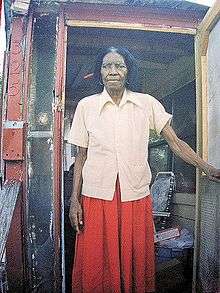Sarah Mary Taylor
Sarah Mary Taylor (August 12, 1916 – 2000) was an African American quiltmaker from Mississippi.
Sarah Mary Taylor | |
|---|---|
 Taylor in 1997 | |
| Born | August 12, 1916 Anding, MS |
| Died | 2000 |
| Occupation | Artist/Quilter |
| Known for | Fabric Artist & Designer |
Life
Sarah Mary Taylor was born on August 12, 1916 in Anding, Mississippi.[1] She learned quilting from her mother Pearlie Posey when she was young. She lived on plantations in the Mississippi Delta and worked as a housekeeper, cook, and field hand. Late in her life, Taylor was forced to retire from arduous labor due to her failing health. She then earned income through quilting, using the skirts of dresses to create pieced quilts. After her aunt Pecolia Warner's quilts gained recognition from University of Mississippi professors in the late 1970s, Taylor received widespread attention for her appliquéd quilts.
Both Taylor and her mother created quilt and pillow designs that employed red Vodun doll-like figures. Her Mermaid quilt (earlier known as Rabbit) is evocative of the mojo hand, featuring blue hands adjacent to red squares and vodou figures.[2] According to art historian Maude Southwell Wahlman, Taylor "has made numerous quilts that play on the symbolic connotations and aesthetic qualities of the hand image."[3] Wahlman writes that Taylor's Cross quilt may represent a continuation of the Kongo cosmogram, a Kongo religious symbol.[3] Taylor's quilts also employ incongruous and clashing color combinations.[4] She was commissioned to make a hand quilt for the film The Color Purple. Both this quilt and an appliquéd word quilt of hers form part of the Ella King Torrey Collection of African American Quilts.[5]
Taylor married five times and had one child, Willie, who preceded her in death. She died July 10, 2000.
Taylor's quilts have been displayed in Naperville, Illinois,[6] Santa Fe, New Mexico,[7] and Philadelphia, Pennsylvania,[8] among other American cities. Marilyn Nelson wrote the poem "The Century Quilt" for her.[9]
References
- "Sarah Mary Taylor". Smithsonian American Art Museum. Retrieved 2 October 2017.
- Wahlman, Maude Southwell (2001). "African Charm Traditions". Self-taught Art: The Culture and Aesthetics of American Vernacular Art. Jackson: University Press of Mississippi. p. 164. ISBN 1-57806-380-9.
- Wahlman, Maude Southwell (November 1986). "African Symbolism in Afro-American Quilts". African Arts. 20 (1): 74–75. JSTOR 3336568.
- White, Shane; White, Graham (1999). Stylin': African American Expressive Culture from Its Beginnings to the Zoot Suit (1st ed.). Ithaca, N.Y.: Cornell University Press. p. 82. ISBN 0-8014-8283-6.
- Che, Jenny (December 12, 2014). "Philadelphia Museum of Art to Show Two Centuries of Black Artists". Wall Street Journal.
- "Art Reception," Daily Herald (October 27, 1996): 389. via Newspapers.com

- "Artist's Reception," Santa Fe Reporter (March 29, 1995): 18. via Newspapers.com

- Sarah Mary Taylor, "Hands Quilt," permanent collection of the Philadelphia Museum of Art.
- Waniek, Marilyn Nelson (1994). The Fields of Praise: Poems. LSU Press. pp. 72–73. ISBN 0-8071-4120-8.